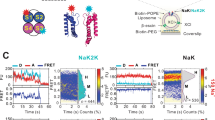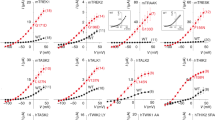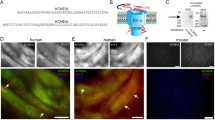Abstract
A conservative reversion at position 374 in a chimeric K+ pore, CHM, switched the preferred ionic conductance from K+ to Rb+. To understand how selectivity was switched, codons for 18 different amino acids were substituted at position 374 in each of two different K+ channels CHM and Kv2.1, the host channel for CHM. After injection of cRNA into Xenopus oocytes, less than half of the substituted mutants expressed functional channels. In both CHM and Kv2.1, channels with the substituted hydrophobic residues Val or Ile expressed Rb+-preferring pores while channels with the substituted polar residues Thr or Ser expressed K+-preferring pores. Val or Ile stabilized while Thr or Ser destabilized blockade by internal tetraethylammonium (TEA) confirming the importance of hydrophobic interactions for blockade. TEA blockade was dependent upon the charge carrier and was more effective in the presence of the ion having the larger conductance. The results are consistent with a model in which the side chains at position 374 form a filter for K+ and Rb+ ions and a site for blockade by internal TEA.
Similar content being viewed by others
References
Andersen OS (1984) Gramicidin channels. Annu Rev Physiol 46:531–548
Armstrong CM (1971) Interaction of tetraethylammonium ion derivatives with the potassium channels of giant axons. J Gen Physiol 58:413–437
Baumann A, Krah-Jentgens I, Mueller R, Mueller-Holtkamp F, Seidel R, Kecskemethy N, Casal J, Ferras A, Pongs O (1987) Molecular organization of the maternal effect region of the Shaker complex of Drosophila: characterization of an IA channel transcript with homology to vertebrate Na+ channel. EMBO J 6:3419–3429
Bogusz S, Boxer A, Busath D (1992) An SS1-SS2 β-barrel structure for the voltage-activated potassium channel. Protein Eng 5:285–293
Chandy KG (1991) Simplified gene nomenclature. Nature 352:26
Frech GC, VanDongen AMI, Schuster G, Brown AM, Joho RH (1989) A novel potassium channel with delayed rectifier properties isolated from rat brain by expressing cloning. Nature 340:642–645
French RJ, Shoukimas JJ (1981) Blockage of squid axon potassium conductance by internal tetra-N-alkylammonium ions of various sizes. Biophys J 34:271–291
Hartmann HA, Kirsch GE, Drewe JA, Taglialatela M, Joho RH, Brown AM (1991) Exchange of conduction pathways between two related K+ channels. Science 251:942–944
Heinemann SH, Terlau H, Stühmer W, Imoto K, Numa S (1992) Calcium channel characteristics conferred on the sodium channel by single mutations. Nature 356:441–443
Hille B (1992) Ionic channels in excitable membranes, 2nd edn. Sinauer, New York
Kamb A, Iverson LE, Tanouye MA (1987) Molecular characterization of Shaker, a Drosophila gene that encodes a potassium channel. Cell 50:405–413
Kirsch GE, Taglialatela M, Brown AM (1991) Internal and external TEA block in single cloned K+ channels. Am J Physiol 30:C 583-C 590
Kirsch GE, Drewe JA, Hartmann HA, Taglialatela M, De Biasi M, Brown AM, Joho RH (1992) Differences between the deep pores of K+ channels determined by an interacting pair of non-polar amino acids. Neuron 8:499–505
Kirsch GE, Drewe JA, Taglialatela M, Joho RH, De Biasi M, Hartmann HA, Brown AM (1992) A single nonpolar residue in the deep pore of related K+ channels acts as a K+: Rb+ conductance switch. Biophys J 62:136–144
Moorman JR, Kirsch GE, Brown AM, Joho RH (1990) Changes in sodium channel gating produced by point mutations in a cytoplasmic linker. Science 250:688–691
Noda M, Shimizu S, Tanabe T, Takai T, Kayano T, Ikeda T, et al. (1984) Primary structure of electrophorus electricus sodium channel deduced from cDNA sequence. Nature 312:121–127
Nozaki Y, Tanford C (1971) The solubility of amino acids and two glycine peptides in aqueous ethanol and dioxane solutions. J Biol Chem 246:2211–2217
Papazian DM, Schwarz TL, Tempel BL, Jan YN, Jan LY (1987) Cloning of genomic and complementary DNA from shaker, a putative potassium channel gene from Drosophila. Science 237:749–753
Richards FM (1977) Areas, volumes, packing, and protein structure. Annu Rev Biophys Bioeng 6:151–176
Roux B, Karplus M (1991) Ion transport in a model gramicidin channel. Biophys J 59:961–981
Sala S, Matteson DR (1991) Voltage-dependent slowing of K channel closing kinetics by Rb+. J Gen Physiol 98:535–554
Sambrook J, Fritsch EF, Maniatis T (1989) Molecular cloning, 2nd edn. Cold Spring Harbor Laboratory Press, New York
Shapiro MS, DeCoursey TE (1991) Permeant ion effects on the gating kinetics of the type L potassium channel in mouse lymphocytes. J Gen Physiol 97:1251–1278
Stevens CF (1991) Making a submicroscopic hole in one. Nature 349:657–658
Taglialatela M, VanDongen AMJ, Drewe JA, Joho RH, Brown AM, Kirsch GE (1991) Patterns of internal and external tetraethylammonium block in four homologous K+ channels. Mol Pharmacol 40:299–307
Taglialatela M, Kirsch GE, VanDongen AMJ, Drewe JA, Hartmann HA, Joho RH, Stefani E, Brown AM (1992) Gating currents from a delayed rectifier K+ channel with altered pore structure and function. Biophys J 62:34–36
VanDongen AMJ (1992) Transit: a new algorithm for analyzing single ion channel data containing multiple conductance levels. Biophys J 61:A 256
VanDongen AMJ, Frech GC, Drewe JA, Joho RH, Brown AM (1990) Alteration and restoration of K+ channel function by deletions at the N- and C-termini. Neuron 4:433–443
Wolfenden RV, Cullis PM, Southgate CCF (1979) Water, protein folding, and the genetic code. Science 206:575–577
Yellen G (1984) Ionic permeation and blockade in Ca2+-activated K+ channels of bovine chraffin cells. J Gen Physiol 84:157–186
Yellen G, Jurman M, Abramson T, MacKinnon R (1991) Mutations affecting internal TEA blockade identify the probable pore-forming region of a K+ channel. Science 251:939–942
Yokoyama S, Imoto K, Kawamura T, Higashida H, Iwabe N, Miyata T, Numa S (1989) Potassium channels from NG108-15 neuroblastoma-glioma hybrid cells. FEBS Lett 259:37–42
Yool AJ, Schwarz TL (1991) Alteration of ionic selectivity of a K+ channel by mutation of the H5 region. Nature 349:700–704
Author information
Authors and Affiliations
Rights and permissions
About this article
Cite this article
Taglialatela, M., Drewe, J.A., Kirsch, G.E. et al. Regulation of K+/Rb+ selectivity and internal TEA blockade by mutations at a single site in K+ pores. Pflugers Arch. 423, 104–112 (1993). https://doi.org/10.1007/BF00374967
Received:
Revised:
Accepted:
Issue Date:
DOI: https://doi.org/10.1007/BF00374967




